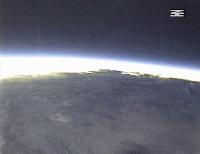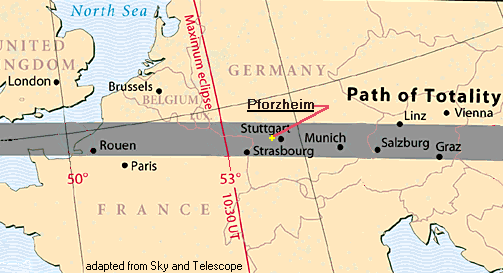 full screen
full screen
 full screen
full screen
The successful ECLIPSE PICTURES from altitude! (courtesy of Dr. Rech of the Pforzheim University of Applied Science)
Pforzheim University balloon project website pointers:

Balloon mission general description (german-to-english translation from the Pforzheim website text):
The University of Pforzheim, Germany will launch, on the occasion of the total solar eclipse of August 11, a helium-filled high altitude balloon with an ATV instrument platform. The goal is the observation of the moon's shadow on earth from a great height. The onboard video camera will transmit pictures live to the Pforzheimer market place and at the same time to the Internet.
The goal is not to view the eclipse as could be done from the earth, but to view the shadow of the moon falling on the earth. This shadow travels with two-and-one-half times the speed of sound over the earth's surface. Even with clouds present the shadow will still be visible from high above the cloud layer - our project is thus independent of the weather.
The balloon flight will begin around 11:00 hours in the proximity of Ettlingen. It rises with a rate of approx. 6 meters/second and achieves at the time of the solar eclipse a height of 25 kilometers. In comparison passenger jets fly to approx. 10 km height and the space shuttle missions to approximately 200 km height. With an upper wind direction of west the balloon will then most likely be above Pforzheim. As a consequence of this great altitude, the line of sight to the horizon will span 500 km.; only the earth's curvature will be a limiting factor, since there is no atmospheric obstruction from vapor or clouds.
The moon's shadow on the earth moves at 2700 km/h coming from a west-northwest direction. During a total period of approx. 10 minutes, i.e., for several minutes before the local darkening to several minutes after, we expect fascinating pictures from the perspective of a near earth satellite.
The camera has a view of 90 degrees, i.e. from the horizon to straight downward. The TV camera image has the resolution of a normal television picture. The environmental conditions are very difficult at a height of 25-30 km: a temperature of -30 Celsius with an air pressure reduced to only few per cent of the pressure on earth, as well as virtually unfiltered UV radiation of the sun. That intense light, together with mechanical stresses of expansion after 1 to 2 hours, causes the blow-out of the balloon and to the landing of the payload by the parachute at some location in South Germany.
The balloon is a weather balloon and consists of a latex envelope with a weight of 1 kg. On the ground it's filled with helium to a diameter of 2 meters and expands during the flight to about 8-10 meters. Balloon, parachute and radar reflector (for the air traffic control authority to track) form the system suspending the payload. This payload consists of two sections, which are directly one above the other (see diagram). The upper platform carries the navigation system, which consists of a government receiver and transmitter for the transmission of the balloon position. This system can operate for several days, thus facilitating recovery well after the landing.
The lower instrument platform carries employs active attitude control to stabilize the line of sight of the camera installed there. Additionally the camera can be turned by remote control of the ground station in order to follow the movement of the moon's shadow. The video transmitter is limited to a period of operation of approx. 2 hours.
The components of the system were developed at the university with the participation of several students. The instrument package has already proven its fitness in a test flight on November 14, 1998.